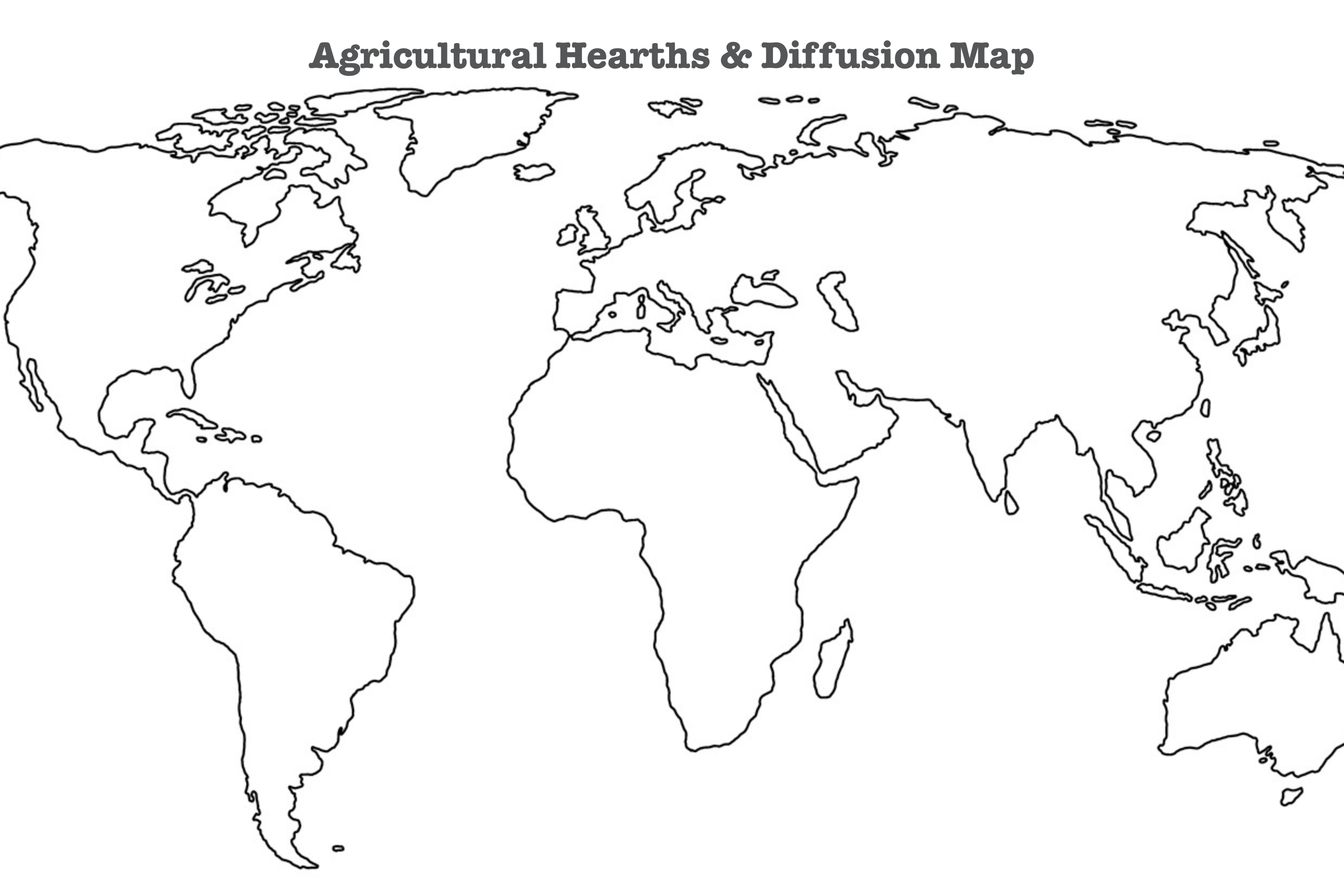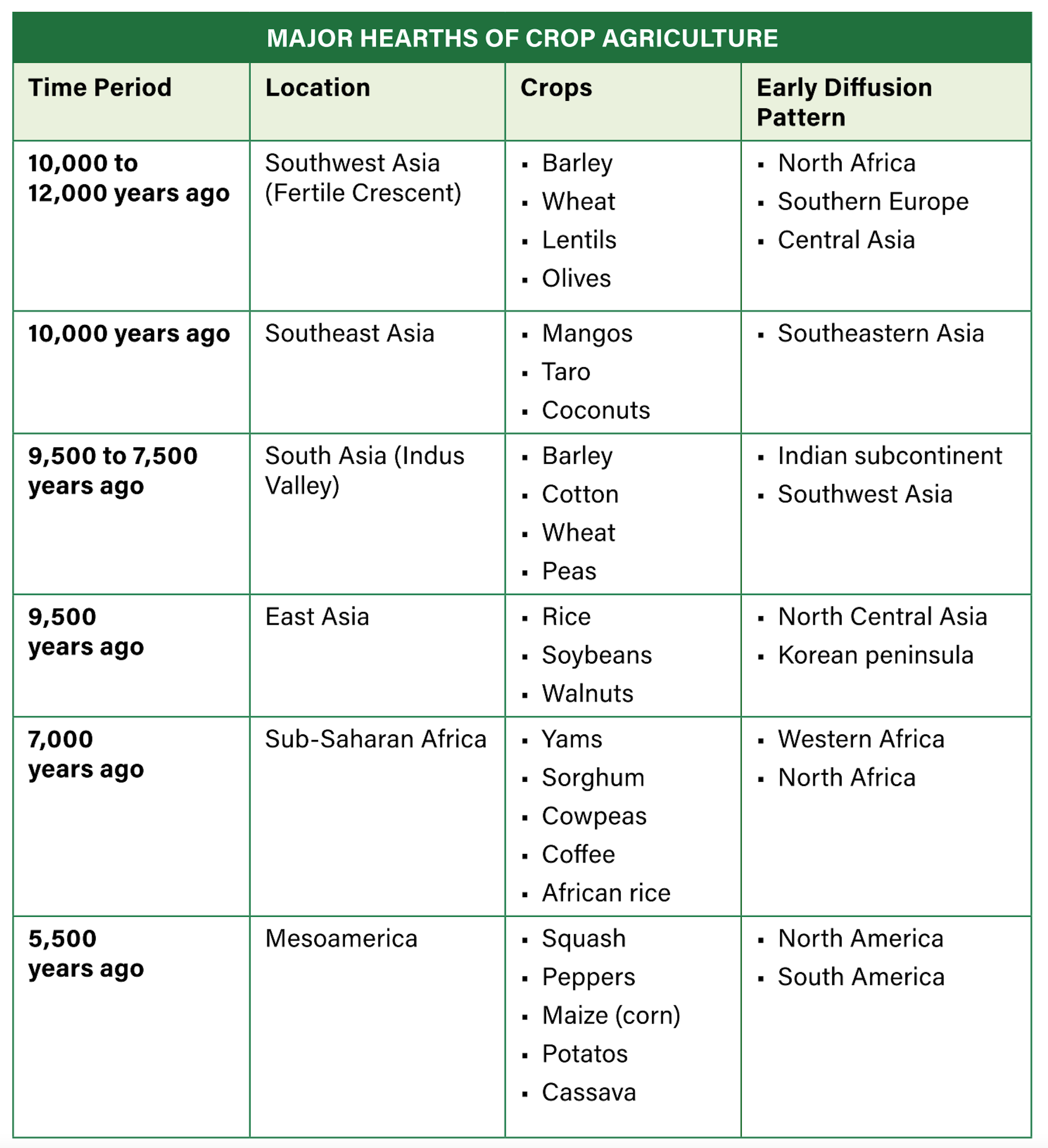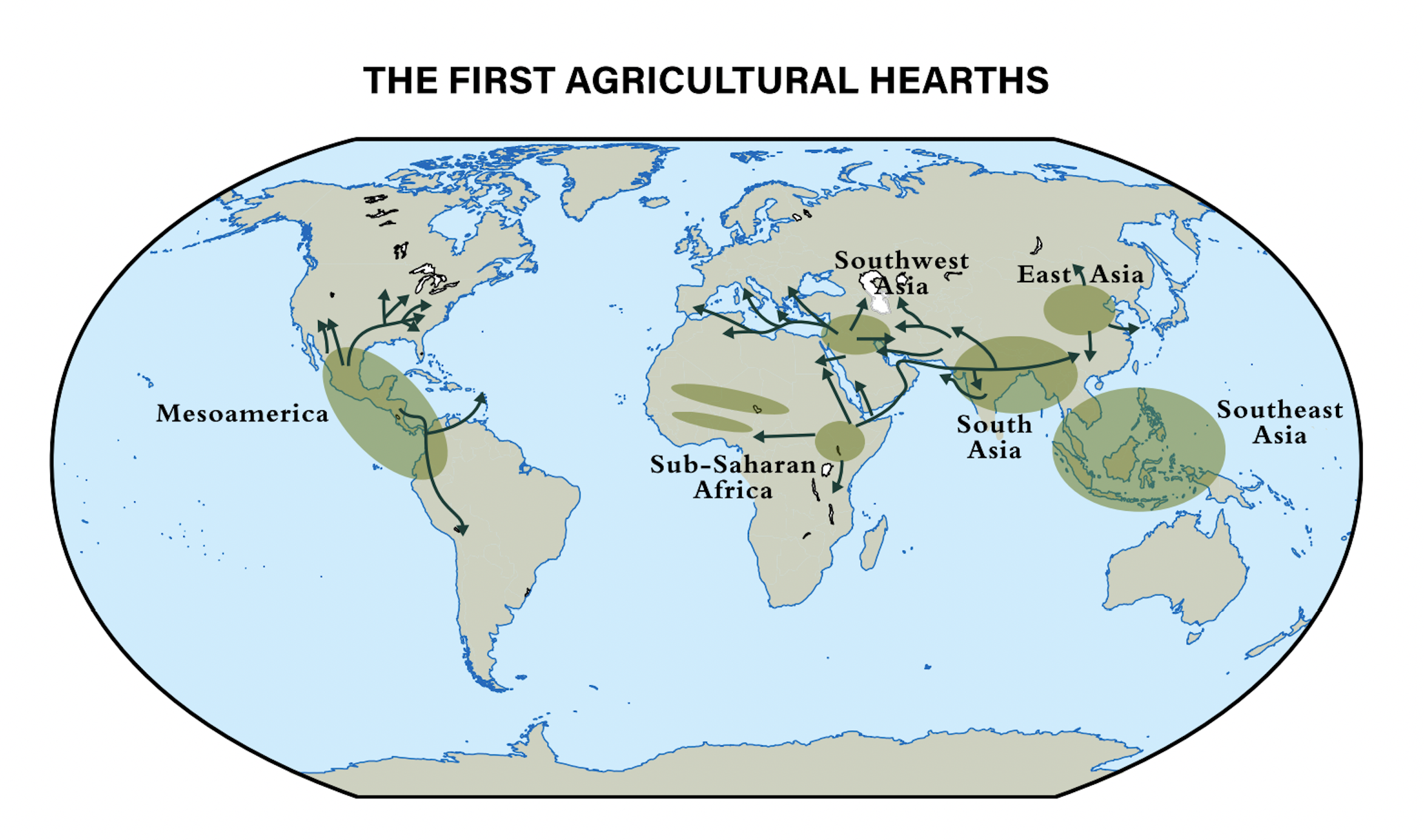Agricultural Hearths
fertile crescent
sub-Saharan Africa
Central America
East Asia
Southeast Asia
Agricultural Diffusion
Columbian Exchange
Silk Road
historic migration patterns

Directions
Create a colored thematic map that illustrates the cultural hearths of the first agricultural locations around the world and the major food crops, along with the two listed diffusion events with the major plants and animals.
Hearths
- Fertile Crescent
- Sub-Saharan Africa
- Central America
- East Asia
- Southeast Asia
Diffusion
- Columbian Exchange
- Silk Roads

Until humans learned to produce a regular, predictable food source, searching for food consumed their time. But as people learned to grow crops, they eventually had time to develop new nonagricultural technologies. The development of agriculture was a gateway to other advances.
Centers of Plant and Animal Domestication
The First (Neolithic) Agricultural Revolution was the origin of farming. It was marked by the domestication of plants and animals. Much of the farming that took place during this time was subsistence farming, when farmers consumed the crops that they raised using simple tools and manual labor. The First Agricultural Revolution began in five centers, or hearths. The first hearths were in Southwest Asia, East Asia, South Asia, Africa, and the Americas.
Agricultural Hearths
In the mid-20th century, geographer Carl Sauer was among the first to argue that people in various times and locations developed agricultural hearths independently. He claimed the first hearths were in areas with high biodiversity on the edge of forests. Additional common characteristics of hearths include available fresh water, fertile soils, moderate climates, and skilled residents. Before humans developed agriculture, they had existed as hunters and gatherers for tens of thousands of years. They lived in small, mobile groups approximately 30 to 50 people-who could move easily in search of food. Larger groups would have surpassed the carrying capacity of their respective regions. People survived by living in low population density regions.
Animal Domestication
Hunters in Central Asia were probably the first people to domesticate animals. They raised dogs and horses for protection, work, transportation, or as a food source. Later, agriculturalists in Southwest Asia kept goats, pigs, sheep, and cattle. People then domesticated cats, horses, camels, donkeys, and llamas, among other animals.
Plant Domestication
Growing crops probably began after domestication of animals. People first used vegetative planting, or using parts of the stems or roots of existing plants to grow others. Planting seeds came later. Eventually, people in separate hearths began to trade crops, animals, and innovations.

The development of agriculture allowed people to live in permanent, higher-density communities. These communities were usually along rivers, which provided a source of water for people to drink. Rivers also provided a source of food (fish), a means of transportation for trade with other people, and at times, defense from other groups.
But rivers such as the Nile, the Chang Jiang, and the Indus had another benefit. They flooded regularly, which spread nutrients across the land that contributed to soil fertility. Since this made agriculture more productive, farmers could support denser settlements, and it freed more people to specialize in tasks other than growing food. People could dedicate themselves to building stronger structures in which to live and store products, providing protection from predators and enemies (military), and developing new ideas and products. Increases in agricultural productivity spurred creativity and advances in all areas of human life.

Diffusion of the First Agricultural Revolution
The first major hearth of agriculture is the Fertile Crescent in Southwest Asia. The area extends from the eastern coast of the Mediterranean Sea and continues in an arc along the Tigris and Euphrates rivers to the Persian Gulf. Other major hearths existed along large river valleys such as the Chang Jiang (Yangtze) and Huang He (Yellow) valleys in East Asia, the Ganges valley in South Asia, and the Nile valley in northeastern Africa. In each location, people raised a variety of domesticated crops and animals.
In some cases, crops and animals were domesticated in multiple regions with seemingly no interaction among the people. This is called an independent innovation. For example, wheat was domesticated independently in Southwest Asia, East Asia, and South Asia. Pigs were domesticated in Southwest Asia, Southeast Asia, and South Asia.
Unique to the hearth of the Americas was the domestication of maize (corn), sweet and white potatoes, and tomatoes. Through diffusion, these products are now important parts of diets throughout most of the world.
Impacts of Hearths and Agriculture
The major hearths of agriculture led to the first urban centers. These first settlements grew into the first civilizations-large societies with cities and powerful states. Civilization brought increased trade, larger empires, and conquest. As societies continued to develop, people had time to specialize in their work and develop new occupations and technologies. This led to the advent of full-time metalworkers, artists, soldiers, weavers, and other specialized jobs.
Over thousands of years, agriculture spread widely and led to increased trade. The diffusion paths in the ancient world were expansive considering the transportation technology of the time. For example, the Roman Empire, which reached its geographic peak around 200 C.E., carried on extensive trade in wheat and other agricultural products with present-day England, Africa, and Southwest Asia. On the Silk Roads, the land and sea routes connecting East Asia to the Middle East and Rome, people traded silk, rice, and other goods.
The Columbian Exchange
One of the most dramatic shifts in agriculture came after the voyage of Christopher Columbus in 1492. The Columbian Exchange was the global movement of plants and animals between Afro-Eurasia and the Americas. Europeans brought hundreds of plants and animals west across the Atlantic Ocean to the Americas and took hundreds of plants and animals back east. Crops such as coffee (originally from eastern Africa) and bananas and sugarcane (originally from New Guinea) continue to thrive today in the tropical climates of the Americas. Temperate climate crops such as potatoes (originally from northwest South America) and maize (originally from southern Mexico) are still extensively grown in Europe, Asia, Africa, and the Americas.
Domesticated animals from the Eastern Hemisphere, such as cattle, goats, and horses, were also brought to the Western Hemisphere. The turkey was originally found in the Americas and taken by Europeans back to their respective countries.
In addition to the agricultural exchange, there were many diseases that were also diffused across the Atlantic Ocean to the Americas, including smallpox, influenza, malaria, and measles. All of these had a devastating impact on indigenous populations. Tens of millions of people died, with the total population decreasing as much as 90 percent within a few generations of contact with European diseases.

Modern Diffusion
Diffusion of agricultural products, techniques, and technologies continued as civilizations became more advanced. The impact of the Industrial Revolution, which started in Great Britain in the mid-18th century, marked the Second Agricultural Revolution. New machines, coupled with scientific discoveries to better preserve food, increased the food supply exponentially. Industrialization diffused across Europe about the same time as it reached the Americas, and ever since, most of Europe, the United States, and Canada have continued to be global leaders in food production and distribution.
By the mid-20th century, Green Revolution scientists created new crossbred or hybrid seedlings in a laboratory. These seedlings are used in more climatically restrictive regions and allowed people to produce food for themselves. This has helped to support growing populations in the semiperiphery countries of Mexico, India, and Indonesia.
